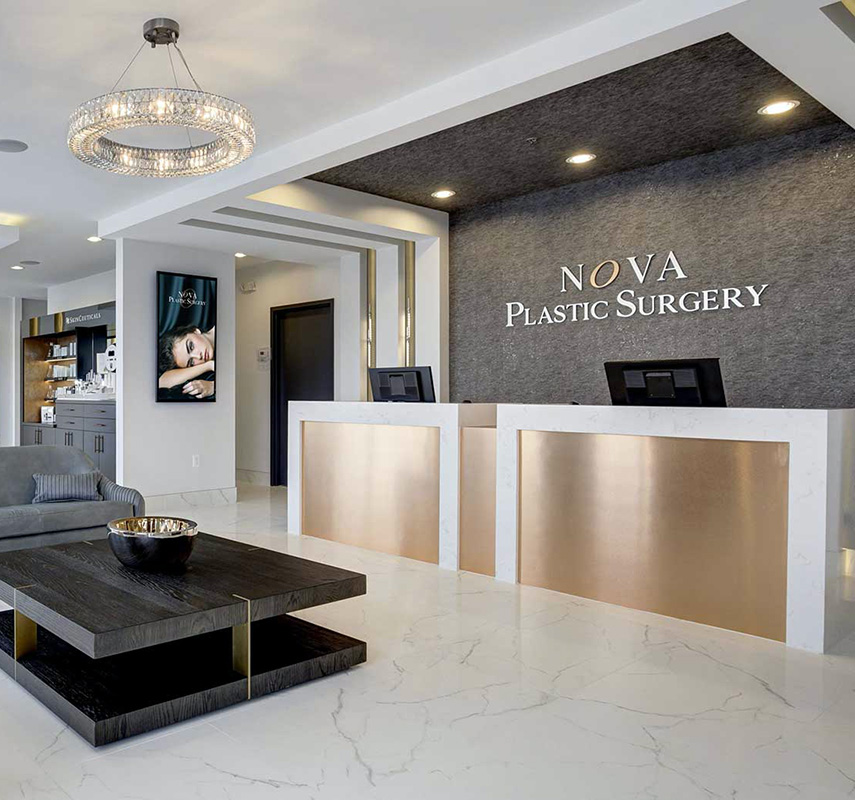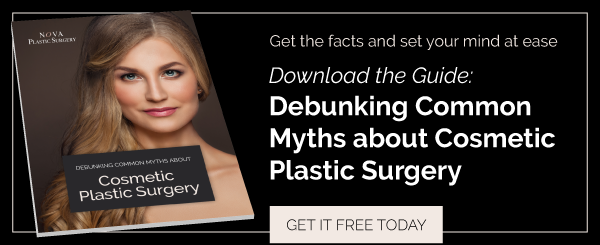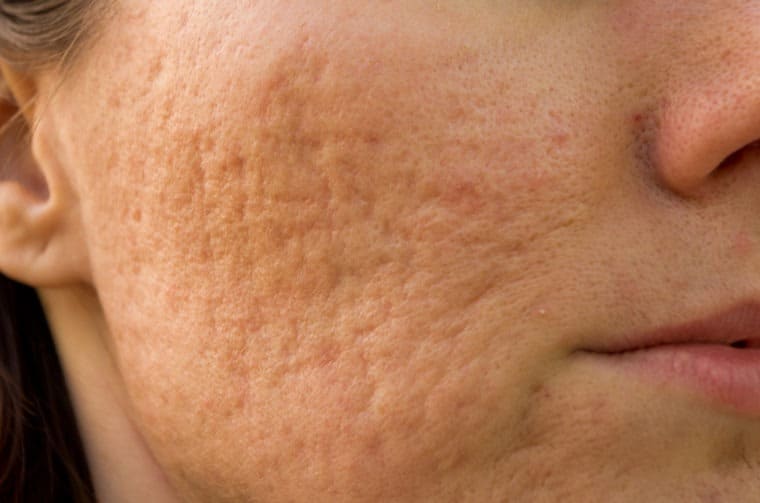
Girl with problematic skin and acne scars
By Dr. Fadi Nukta
Acne is a problem that many young people face, and in several cases, it continues well through adulthood. One of the long-lasting effects of acne is severe scarring that can last much longer than the acne itself. The irregularities caused by the scars unnaturally reflect the light, which leads to a dull matte appearance. The prolonged inflammatory process that acne sufferers go through often leads to significant pigmentation and discoloration of the scars, which leaves the skin looking lackluster, uneven, and discolored.
Acne scars usually run deep into the dermis, making them very hard to treat with simple over-the-counter medications and creams. Even medical treatments often lack the necessary potency to penetrate deep into the affected layers. Therefore, only professional medical treatments can have a true effect with noticeable results.
As physicians and other aesthetic service providers, we pursue evidence-based treatments to deliver optimal outcomes with the least risk to our patients. When determining which acne scar treatments to offer patients, we look for an option that delivers results that the patient can both see and feel to obtain the highest level of patient satisfaction with their aesthetic procedure.
To accomplish this, we must look at the unique mechanisms behind acne scar formation and explore options that address these mechanisms on a more personalized level.
Acne Scars: Types and Mechanism of Formation
Acne vulgaris, which involves an inflammatory blockage of pilosebaceous units (hair follicles as well as the adjacent sebaceous gland), is a common chronic condition particularly prevalent among those in late adolescence. Most people experience acne during their lifetime, but only a small sector of the population—an estimated 14 percent—deals with moderate to severe acne, which may result in deep and permanent scarring. Though one might think of all scars as the same, the mechanisms behind acne scarring are actually quite diverse.
Ice Pick Scars
These very deep and narrow scars extend into the dermal layers and may appear as large open pores or smaller holes on the face. Ice pick acne scars develop as the acne infection works its way from deep under to the surface, destroying tissue as it rises.
Boxcar Scars
These wider, oval-shaped scars have deep vertical sides, giving the skin a very irregular appearance. Unlike ice pick scars, boxcar scars are instantly and unmistakably identifiable as belonging to someone who suffered from extreme acne. A boxcar scar forms when the acne inflammation destroys collagen, leaving sunken spots on the face.
Rolling Scars
These scars appear to roll across the skin like stationary waves. Though they are defined as “scars,” they are not as distinct as the scars mentioned above; they simply make the face appear uneven. Rolling scars develop when fibrous tissue bands form between the epidermis and the subcutaneous layer. These fibers act like adhesive, pulling the epidermis down and attaching it to the underlying subcutaneous tissues.
Keloid Scars
A keloid is a significantly raised and often discolored scar that typically occurs when a person has experienced a deep epidermal trauma. An estimated 6-16 percent of the African population and a smaller but substantial portion of the Hispanic population has this form of scarring, in which keloid scar tissue not only appears at the site of the cellular damage but extends beyond it. A person who develops keloid scarring experiences an overproduction of collagen, which often greatly exceeds the amount needed to heal the acne wound, leaving a scar with a radius far extending the actual cellular damage.
Post-Inflammatory Hyperpigmentation
People with lighter skin may experience hyperpigmentation resulting from acne. In this case, the skin produces too much melanin at the scar site. However, this form of acne scarring typically resolves itself within a few months.
Acne Scar Treatment Options
As exemplified above, acne scarring is not a surface level problem, so even professionally prescribed surface treatments don’t work as effectively as patients would like. Some dermatologists or other providers may suggest:
- Microneedling
- Alpha-beta peels
- Dermal fillers
- Skin pigment gels
- Ascorbic acid treatments
These are all examples of surface treatments, and most dermatologists and plastic surgeons will instruct patients to manage their expectations. In other words, the treatment may work, but never to the extent that a patient will be fully pleased with the outcome
Ablative resurfacing is more effective, but it must ablate the entire skin to get to the depth of the problem, leading to a very long recovery and increased chance of complications. This is why fractionated laser technology is our best option for treating acne scars.
Profractional laser was introduced to enable medical professionals to treat deep and superficial acne scars with shorter recovery and a lower risk of complications. Profractional laser uses the same types of lasers mentioned above, but instead of resurfacing the entire treated area, it creates narrow channels in the skin. This results in localized and well-controlled cellular damage that rejuvenates the skin cells and stimulates the body to create its own new dermal and epidermal cells that have all the components of new, healthy skin. This process remodels the skin, restoring its glow and even surface. The main advantage associated with profractional laser is the ability to treat much deeper scars without the prolonged downtime associated with ablative lasers.
Treating Acne Scars Using Fractionated Laser Technology
Fractional laser technology effectively treats deep acne scars with minimal downtime, unlike other acne scarring treatments. Because of the hyper-targeted nature of fractionated laser, patients need no bandages, wound care, or painkillers and can return to normal activities almost immediately.
Doctors can ablate precisely, reducing collateral cellular damage, which allows the untouched surrounding tissue to support the treated dermis as it heals more quickly and evenly. Fractionated laser gives a physician incredible control over treatment depth so they can treat very minimally or aggressively in various regions of the face to deliver the best results to patients.
Fractionated laser not only gets to the heart of the problem, breaking up deep-rooted scar tissue; it softens and smooths the skin in a way that patients can both see and feel. It’s for that reason that patient satisfaction after fractionated laser treatment is so impressively high.
The main advantage associated with profractional laser is the ability to treat much deeper scars without the prolonged downtime associated with ablative lasers. This gave medical providers a great tool to treat superficial scars and deep scars without using deep ablation of the entire skin surface. The results are similar to those of an ablation, but with much less potential of side effects and discomfort and a much shorter recovery.
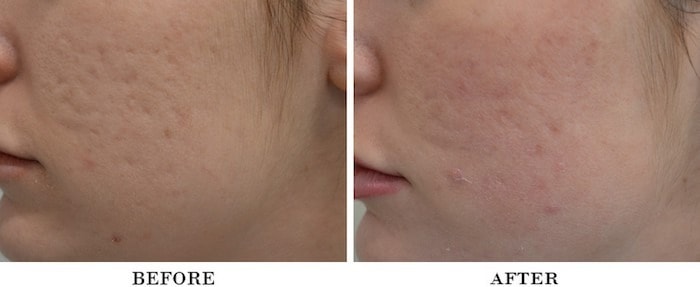
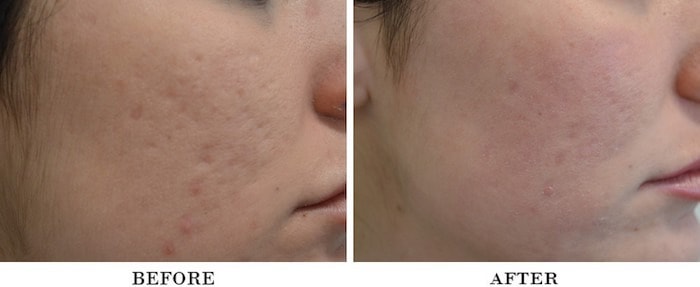
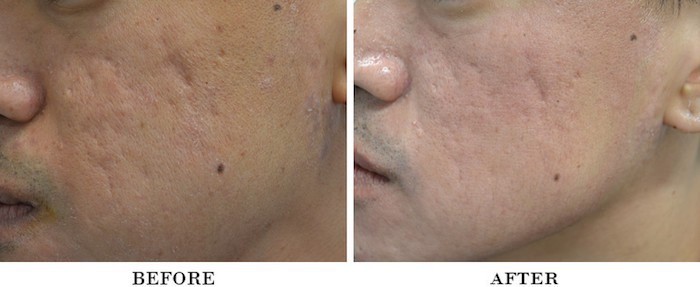
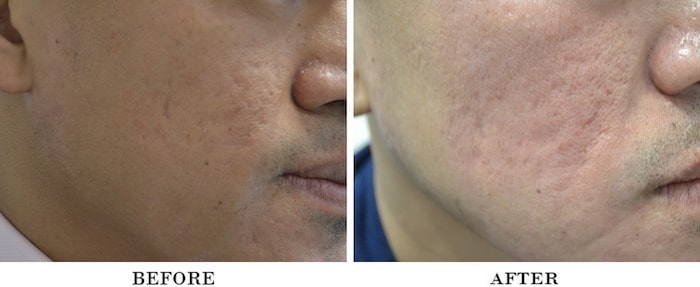
NOVA Plastic Surgery’s Approach to Acne Scar Treatment with Fractionated Laser Technology
Acne scar treatments at our clinic are very individualized and are tailored with four factors in mind:
- The degree of scarring: Deeper scarring requires deeper laser localized to those areas, while less prominent scarring requires a more superficial laser treatment.
- The location of the scars: Profractional laser on the forehead is applied at a more superficial level than that on the cheeks or chin.
- Other skin damage: Very often, a patient will have multiple skin conditions, such as pigmentation, red broken vessels, and fine lines and wrinkles. Often, those patients will have a combination of a profractional laser treatment with a more superficial micro or nano laser peel to treat a multitude of skin conditions.
- Patient’s tolerance: Numbing creams or numbing injections are usually required based on the depth of the scars. However, patients’ tolerance levels can vary. Some will barely feel very deep laser treatments, while others find it hard to tolerate more superficial treatments. Therefore, the depth can be adjusted during the treatment based on a patient’s feedback. For the best outcome, our providers will have a plan in which deeper scars can be numbed with local injections and more superficial scars can be numbed with topical cream.
Since most patients getting laser treatments for acne scarring are in their 30s and beyond, these patients tend to see another extremely welcomed side effect … Wrinkles are less superficial than deep acne scars, so improving the scarring invariably causes a significant improvement in wrinkles and gives the face a youthful, rejuvenated look.
“I was so self-conscious about my acne scars until after I had profractional laser treatment. Now my makeup goes on smoother and I feel more confident in my skin. I can’t wait to have my next one for even better results!”
-Tara H.
What To Expect During Your Consultation
During the initial consultation, one of our providers will discuss the patient’s concerns and aesthetic goals. A focused medical and surgical history is completed, which includes any past prescriptions or medicines aimed at treating the acne or scars. For instance, a history of using accutane in the previous 6-12 months is a contraindication for the profractional laser treatment.
The type, area, and depth of scars is determined, and a plan is created accordingly. Because most patients have a general discoloration and unevenness to their face, a micro laser peel or a nano laser peel is usually combined with the profractional laser treatment. In some cases, combining the profractional laser treatment with PRF for the treatment of acne scars has shown great effectiveness in treating wounds or scars. This process utilizes the healing power of a patient’s own platelets to boost the skin’s collagen regeneration process. When combined with profractional laser, blood is taken from the patient and spun to extract pellets of platelets. These pellets are then applied to the skin and over the channels created by the laser. These channels offer a direct and uninterrupted access for these platelets to penetrate deep into the scar. A study published in the journal of dermatologic surgery showed a statistically significant improvement in the degree of edema and the overall improvement in scars when PRF was combined with laser resurfacing.
On the day of treatment, a numbing cream is applied to the areas of concern. The numbing process lasts about 40-45 minutes and could be followed by an injection of local anesthetic to areas that will receive the deepest level of treatment. These are areas that the provider determines will not be anesthetized enough using a numbing cream alone.
The procedures lasts about 30 minutes, after which SkinCeuticals Hydra Balm is applied. No dressings are applied because these have been found to increase the risk of infection and further scarring. Your provider will give you a detailed post-procedure instruction sheet with any necessary medical supplies to ensure a smooth and safe recovery.
Who Is a Candidate?
According to the American Academy of Plastic Surgery, a good candidate for fractionated laser treatments:
- Doesn’t have active acne
- Has a skin phototype between I (fair) and V (moderately brown) on the Fitzpatrick phototype scale
- Doesn’t have deep wrinkles or significantly sagging skin
Patients with darker skin tones may develop hyperpigmentation, which can often be corrected using bleaching agents, but patients are advised to complete a skin test before proceeding.
The main advantage associated with profractional laser is the ability to treat much deeper scars without the prolonged downtime associated with ablative lasers.
The Negative Effect of Acne Scarring on Life
We’re well aware of the social stigma surrounding people—usually young people—with severe acne. However, it’s not often in the medical community that we discuss the lifelong implications of permanent acne scarring, such as:
- Depression when one feels hopeless to correct such a visible flaw that they must see every time they look in the mirror.
- Anxiety in social situations, such as feeling unattractive to potential partners or a significant other.
- Anxiety in professional situations, such as knowing that potential employers, clients, coworkers, and so on all see and may subconsciously hold bias based on a person’s appearance.
- Low self-esteem. Personal confidence largely dictates one’s success in life. Acne scars can make confidence in oneself and one’s skills or abilities nearly impossible.
- Hampered long-term financial security and money-making potential because of lack of confidence socially and professionally.
- Decreased quality of life.
- Social isolation.
Meet Our Experts
Acne scars are a frustrating skin condition that affects a large demographic of people. Because there are multiple factors to consider, such as the mechanisms behind their formation, the depth of the scarring, and the amount of discoloration or hyperpigmentation present, acne scars can be difficult to treat. However, the experts at NOVA Plastic Surgery can evaluate the areas of concern and customize a profractional laser treatment specifically for you for better efficacy. If you have concerns about acne scars and would like to learn more about profractional laser treatment, contact the experts at NOVA Plastic Surgery for a consultation!

